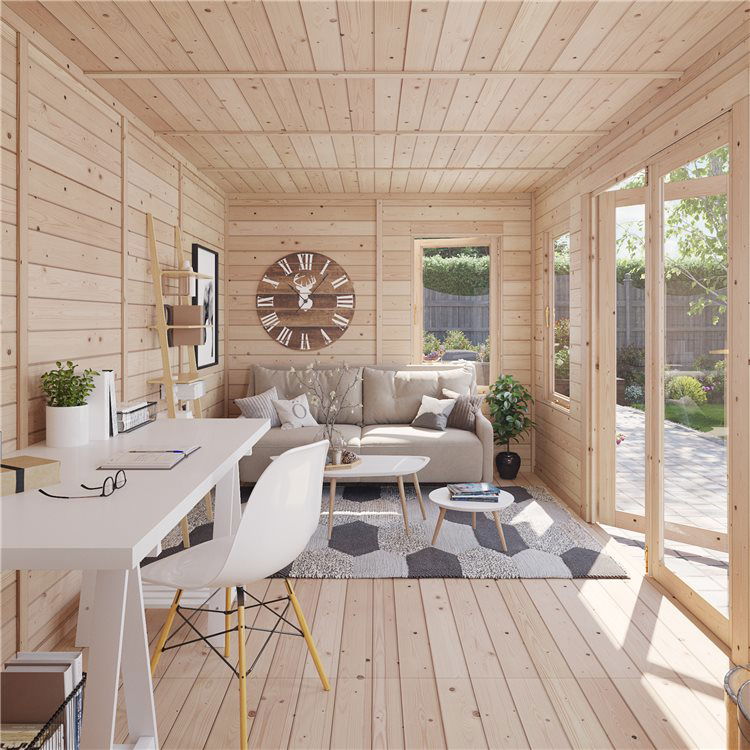Jump to:
Investing in a garden office can revolutionise your work-from-home experience. It offers a dedicated space for productivity while eliminating the hassle of commuting. Truly a game-changer!
But when investing in one, you need to consider how you’ll provide it with reliable Internet. In today’s digital age, having a stable and seamless connection is essential. This is true regardless of where you choose not to work.
Before you make a decision, determine how you’ll connect your garden office to the internet. In some cases, your home office may be close enough to tap into the existing WiFi signal from your house. However, there are instances where the signal might be weak or unable to reach altogether.
If you find yourself in this situation, there’s no need to worry because we’ve got you covered! We’ll walk you through various options to provide your new work area with WiFi connectivity.

Different Types of WiFi
When it comes to WiFi options for your garden office, the choices are tons! Each offers unique features, costs, ease of setup, and other essential factors. To get the best one for you, pay attention to each option’s pros, cons, requirements, and suitability.
It’s also a good idea to know which broadband provider you’re with, as well as the approximate range of your WiFi router. This way, you won’t be forking out for things that are incompatible or that you simply don’t need.
1. WiFi range extender

A range extender for your wifi router is the most basic option out there. Simply put, it extends the signal range of your router so you can connect to it from further away – in your garden office at the end of your garden for instance.
Lots of broadband providers offer range extenders, and some are better and more powerful than others. It’s good to do a bit of research on the range you might need to reach your garden office. Some internet providers are even happy to provide the extenders for free if you have trouble getting signal in some places in your house.
Using one is simple: plug in the range extender, then just connect to the new extended network it creates. Once you’ve done this, you’ll be up and running!
| Pros:
| Simple to set up, easy to use, no complicated installation required. Extenders are also pretty cheap, and you can buy one that fits your internet provider and budget.
|
| Cons:
| Even with the most powerful products, the range extension isn’t huge. If you have a long garden, a range extender is unlikely to reach the end. There can also be a decrease in speeds.
|
| Requirements:
| None – other than your existing wireless router and a plug socket! Just plug and play.
|
| Suitable for:
| Garden Offices that aren’t too far away from your house and don’t need a strong connection.
|
| Price range:
| £20 – £50, depending on where and who you buy the extender from.
|
2. Ethernet cable

An ethernet cable is the old reliable when it comes to getting internet access. It provides a super-strong and consistent wired connection because data is sent along a cable rather than through the air! An ethernet cable will be able to replicate the speed and ping that your internet router receives.
Investing in one is easy and cheap, even for ones that are super long, except the installation part.
If you’re having power cables laid for your garden office, it’s a great idea to ask whoever is installing them to install an ethernet cable at the same time. The cable will connect to your router and run through to the office building. If not, you’ll need to get it installed new – or buy a cable that can survive outdoors (don’t worry, these do exist!).
Once it’s in your garden office, just plug it into a separate router or a device with an ethernet port.
| Pros:
| Ethernet cables provide a strong and stable connection, giving you speeds almost identical to what the router itself receives. They’re also easy to use.
|
| Cons:
| Getting professional installation can be a bit of a pain if you’re just laying the cable. You can lay it outside but doing so is riskier. You’ll also need to buy a new, separate router if you want a wireless signal in your garden building – the cable will only provide a connection to what it is plugged into.
|
| Requirements:
| A long ethernet cable, and ideally the means to install it underground.
|
| Suitable for:
| Offices that need a super strong internet connection. You won’t find the consistency that ethernet cables give you anywhere else.
|
| Price range:
| £15 for the cable, plus £50+ if you need it installed separately.
|
3. Powerline

A powerline extension works by providing an internet connection through your mains power supply. It comes with two adapters – one attaches your original router into a mains socket, and the other takes the connection from the mains and into whatever Ethernet-capable device you want – like a router or pc.
This option operates similarly to an ethernet cable but instead utilises the power cables in your house to move the internet connection around. If you already have mains power supplied to your garden office from your house, for the purposes of lighting it up or powering a heater, and don’t want to add an extra ethernet cable, then a powerline connection is the option for you.
| Pros:
| This option is easy to install if you have mains power in your Garden Office extended from your house (it has to be part of the same wireless network). Powerline extenders are also pretty cheap and deliver a consistent connection.
|
| Cons:
| Since it is using electricity cables, an internet connection provided through powerline will not be as fast as one provided through an ethernet connection. You will likely experience a drop in speed, especially since the connection will be travelling quite far to the Garden Office. You will also need a router or ethernet-capable device.
|
| Requirements:
| A mains power connection that extends to your garden home office.
|
| Suitable for:
| Anyone who has mains power in their garden building and wants an easy and cheap way to extend the connection out there.
|
| Price range:
| £25 – £60, again depending on the brand and store you buy from.
|
4. Point-to-Point
Point-to-Point, or PtP, is a more complex version of a typical WiFi booster. A point to point connection transfers a connection between PtP units with a line of sight between each other. Each unit needs mains power to work and will deliver its connection to an ethernet port.
The connection is delivered through the air, like a typical extender, but the transfer is much faster, more reliable, and can travel much longer distances (provided there is a clear line of sight between them).
| Pros:
| Fast, reliable connection that can be delivered over very long distances.
|
| Cons:
| PtP is very expensive to install – much more so than the other options featured here. They require, again, a router or ethernet capable device on the other end, as well as mains power and a clear line of sight.
|
| Requirements:
| Mains power at both ends (they don’t have to be connected), and a clear line of sight between the two points.
|
| Suitable for:
| A garden office at the end of a very long but clear garden where a powerline connection or ethernet cable is unfeasible for any reason.
|
| Price range:
| £100 – £150. This may be more if you buy one that needs installation.
|
5. 4G or 5G router

A mobile internet router, whether that be 4G or 5G, is probably the final resort when it comes to getting a broadband connection in your garden office. If you can’t get your WiFi connection all the way out to your office, then a mobile internet router can plug that internet-sized hole.
4G and 5G routers use mobile networks to connect you to the internet. Thanks to the quality of these mobile connections, you’ll get a speed that is not much worse – if not comparable to – the one you have in your home. And, with modern connectivity, lots of us now have access to a connection of this type.
All you need is a mobile internet router, available from practically every mobile network provider, and a SIM card with a data plan. Many networks even offer router and data plans if you want to buy just those two!
| Pros:
| No pre-existing WiFi network required – just a 4G or 5G connection and a way to power the router. 4G and 5G speeds are also very fast and reliable – if you’re on a 5G connection you might even see faster speeds than you get on a WiFi network! Installation is also easy and quick.
|
| Cons:
| If you live in a rural area, it might not be possible to get a mobile connection of this kind. You’ll also be paying more since you’ll have to plan for a mobile data plan just like you pay for your mobile phone.
|
| Requirements:
| A strong, 4G or 5G mobile data connection and a wall outlet to power the router.
|
| Suitable for:
| Anyone who can get a data connection but can’t, or doesn’t want, to spend the effort extending their wifi out to their garden office.
|
| Price range:
| £30 – £50, plus a mobile data plan (around £20-30 per month).
|
x.png)
The Benefits
Gone are the days of being tethered to a desk or confined within the walls of a traditional office. Enter WiFi, which brings freedom and flexibility. Integrating this wireless source into your workspace can transform the way you work. You unlock a world of possibilities and create an efficient work environment, including:
Internet access
WiFi enables you to connect to the internet. This allows you to access a vast amount of information and resources. You can browse websites, conduct research, and access online applications with ease. Overall, it enhances your productivity and efficiency.
Communication
WiFi enables seamless communication through various online platforms. You can make voice and video calls, participate in virtual meetings and collaborate. It facilitates real-time communication and reduces the need for physical presence.
Flexibility
With WiFi, you have the flexibility to work from anywhere within the range of the network. You can move around your garden office and choose your preferred working spot. This flexibility can enhance creativity, allowing you to work in a way that suits you best.
Increased productivity
WiFi provides a stable and high-speed internet connection, which is crucial for efficient work. You can quickly download/upload files, stream, and access cloud-based services without interruptions. This helps to improve productivity and reduces delays caused by unreliable internet connections.
Access to cloud services
WiFi enables easy access to cloud-based services and storage. You can store and access files, documents, and data on cloud platforms, such as:
- Google Drive
- Dropbox
- OneDrive
This ensures your work is securely backed up and accessible from any device with internet connectivity.
Internet of Things (IoT) integration
WiFi connectivity allows you to integrate smart and IoT devices into your garden office setup. You can control and automate lighting, security systems, and smart assistants.
Entertainment and relaxation
WiFi also opens up opportunities for entertainment and relaxation during breaks. You can stream music, watch videos, or listen to podcasts for leisure. It can also provide access to online fitness classes or e-books for well-being.
Remote monitoring and security
WiFi enables you to set up security cameras and monitoring systems in your garden office. This allows you to remotely monitor the office space. It ensures safety and security even when you’re not physically present.
Overall, having WiFi in your garden office enables you to make the most of your work environment. It enhances connectivity, productivity, flexibility, and convenience.
Wrapping Up
Whatever the situation in your home with WiFi, there’s a plan out for there you. Whether you just need a simple signal extender, a long ethernet cable to reach out to your office, or a mobile data router to tap into your 5G network, just choose what works best for you and your garden office!
If you’re interested in getting yourself a garden office, then check out our wide range by clicking the button below. Use this garden office interior guide to build your dream WFH workspace!










